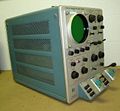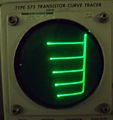575: Difference between revisions
Jump to navigation
Jump to search
No edit summary |
No edit summary |
||
| Line 1: | Line 1: | ||
The Tektronix 575 is a curve tracer for transistors. It can be thought of as being composed of three modules | The Tektronix 575 is a curve tracer for transistors. It can be thought of as being composed of three modules: | ||
# An X-Y display. The vertical and horizontal amplifiers are very similar. | |||
waveform, which generates different traces in the the family of I-V curves of the transistor. | # A step source. This uses a gated miller integrator to generate controlled steps. The result is a staircase waveform, which generates different traces in the the family of I-V curves of the transistor. | ||
# The collector sweep. Power from the mains goes through an isolation transformer and a variac and is rectified to produce the collector sweep voltage. The isolation transformer has two pairs of secondary taps, one for high voltage and low current, the other for low voltage and high current. The maximum power that can be delivered to the transistor in either mode is approximately 200 watts. | |||
one for high voltage and low current, the other for low voltage and high current. The maximum power | |||
that can be delivered to the transistor in either mode is approximately 200 watts. Early versions used | Early versions used | ||
selenium rectifiers. | selenium rectifiers. | ||
Revision as of 20:44, 14 August 2011
The Tektronix 575 is a curve tracer for transistors. It can be thought of as being composed of three modules:
- An X-Y display. The vertical and horizontal amplifiers are very similar.
- A step source. This uses a gated miller integrator to generate controlled steps. The result is a staircase waveform, which generates different traces in the the family of I-V curves of the transistor.
- The collector sweep. Power from the mains goes through an isolation transformer and a variac and is rectified to produce the collector sweep voltage. The isolation transformer has two pairs of secondary taps, one for high voltage and low current, the other for low voltage and high current. The maximum power that can be delivered to the transistor in either mode is approximately 200 watts.
Early versions used selenium rectifiers.




